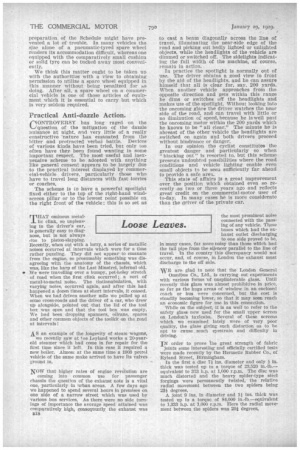Spare-wheel Equipment for the eumatic-tyred Vehicle.
Page 1

Page 2

If you've noticed an error in this article please click here to report it so we can fix it.
A' wit taxatio unladen tyres."
It is even if wheels, has soli but it .h provide vehicle . a solid point to The debar t reduced portant point has arisen in connection the concession of 20 per cent. In the of commercial vehicles of over 2.tons weight " fitted entirely with pneumatic now quite understood that a vehicle, It has pneumatic tyres on its front is debarred from this concession if it Or cushion tyres on the 'rear wheels, s been the practice of sonie makers to for . an othorwise all-pneumatic-tyred spare Wheel *Upon' which Is mounted or cushion tyre, and here arises the which We refer.
ere carrying of Such a wheel might not e vehicle from being licensed at the rate, but if a wheel equipped with such a tyre be employed at any time it • at once renders the 'vehicle subject to the higher rate.
We recently took up this matter with the Ministry of Transport, and the reply is illuminative. It reads as follows :—" I am to point out that the amended Schedule, i.e., the Third Schedule to the Finance Act, 1928, applies the reduced rates of duty only to vehicles fitted entirely with pneumatic tyres.' The Minister, therefore, whilst having no authority to interpret an Act of Paiiiament, is of the opinion that, if a vehicle licensed at a reduced rate of duty applicable to vehicles of a similar class fitted entirely with pneumatic tyres, is on any occasion during the currency of the licence used with one or more nonpneumatic tyres, it becomes liable to duty at the higher rate in accordance witli the provisions of section 14 (1) of the Finance Act. 1922. • Under this the person using the vehicle .would be liable to_ a penalty."
It is most unfortunate that this should be the case, but it is the strict interpretation of the law, and it is not often that an elastic interpretation is made by those who have to enforce the law. Consequently, even if a vehicle has been licensed at the lower scale, the user would certainly be taking a risk if at any time he utilized his non-pneumatic-tyred spare wheel.
This is one of those instances where a little thought and the advice of experts in the The debar t reduced
preparation of the Schedule might have prevented a lot of trouble. In many vehicles the sjze alone of a pneumatic-tyred spare wheel renders its accommodation difficult, whereas one equipped with the comparatively small cushion or solid tyre can be tucked away most conveniently.
We think this matter ought to be taken Up with the authorities with a view to obtaining permission to utilize a spare wheel equipped in this manner without being penalized, for so doing. After all, a spare wheel on a commercial vehicle is one of those articles of equip7 meat which it is essential to carry but which is very seldom required.
Practical Anti-dazzle Action.
CONTROVERSY has long raged on the 4,-s' question of the mitigation of the dazzle nuisance at night, and very little of a really constructive -nature has emanated from the bitter and protracted verbal battle. Devices• of various kinds have been tried, but only too often have they been found wanting in some important respect. The most useful and inexpensive scheme to be adopted with anything like general consent appears to be largely due to the practical interest displayed by commercial-vehicle drivers, particularly those who have to travel long distances with fast lorries or coaches.
The scheme is to have a powerful spotlight fixed either to the top of the right-hand wind-screen pillar or to the lowest point possible on the right front of the Vehicle this is so set as to east a beam 'diagonally across 'the line of travel, illuminating the near-side edge of the road and picking out badly lighted or unlighted objects, while the headlights of the vehicle are dimmed or switched off. The sidelights indicating the full width of the machine, of course, remain in action.
In practice the spotlight is normally out of use. The driver obtains a good view in front by the aid of the headlights, and he can assure himself that all is clear for, say, 200 yards. When another vehicle approaches from the opposite direction and gets within this range he dims or switches off the headlights and makes use of the spotlight. Without looking into the oncoming glare the driver watches the near side of the road, and can travel with little or no diminution of speed, because he is well past the oncoming motor within the 200 yards which he knows to be "all clear." The minute he is abreast of the other vehicle the headlights are switched on again and both drivers proceed without hindrance or danger.
In our opinion the cyclist constitutes the greatest danger and particularly so when "blacking out" is resorted to, but this scheme presents undoubted possibilities where the road conditions and vehicle lighting enable even small objects to be seea sufficiently far ahead to provide a safe area.
This state of affairs is a great improvement over the position which obtained even so recently as two or three years ago and reflects great credit on the commercial-motor user of to-day. In many cases he is more considerate than the driver of the private car.


































